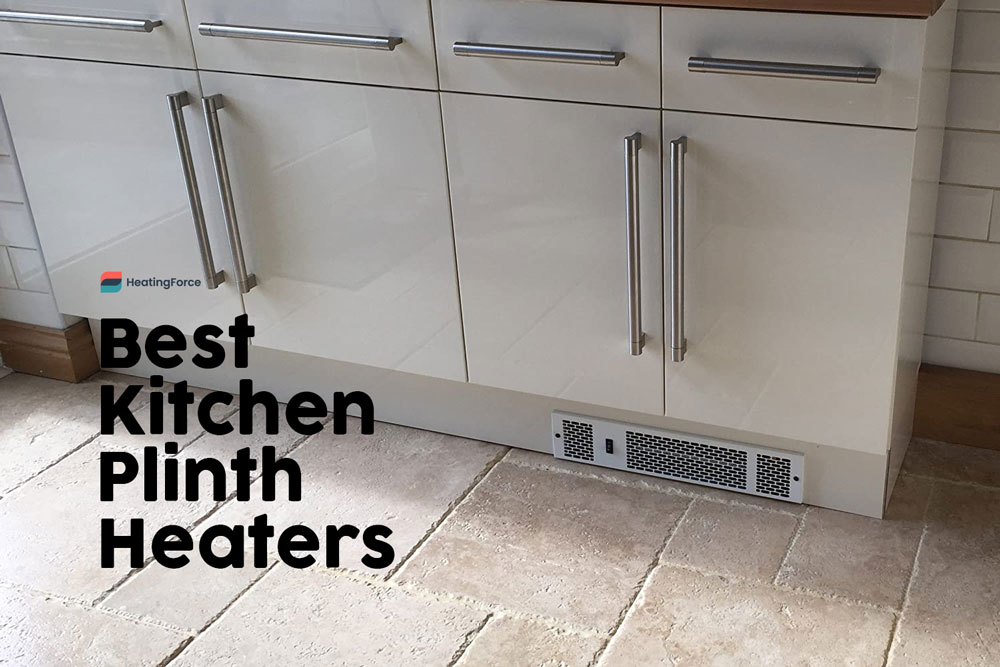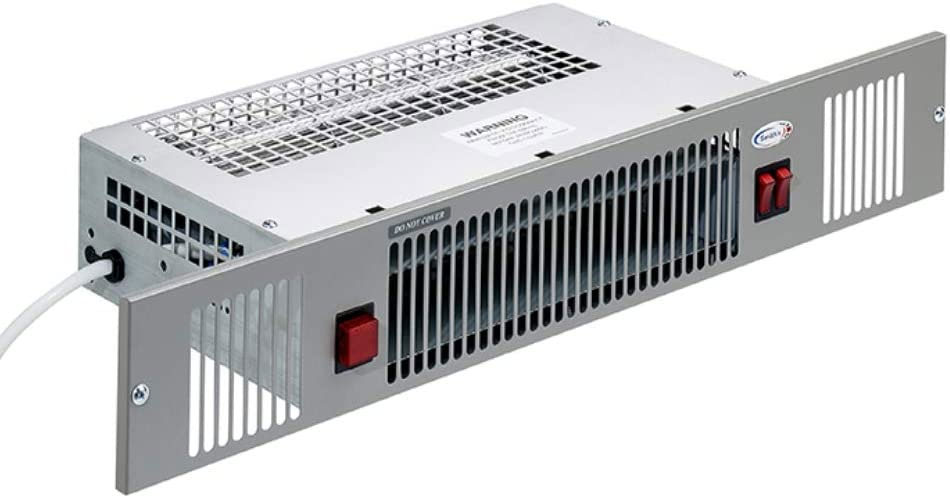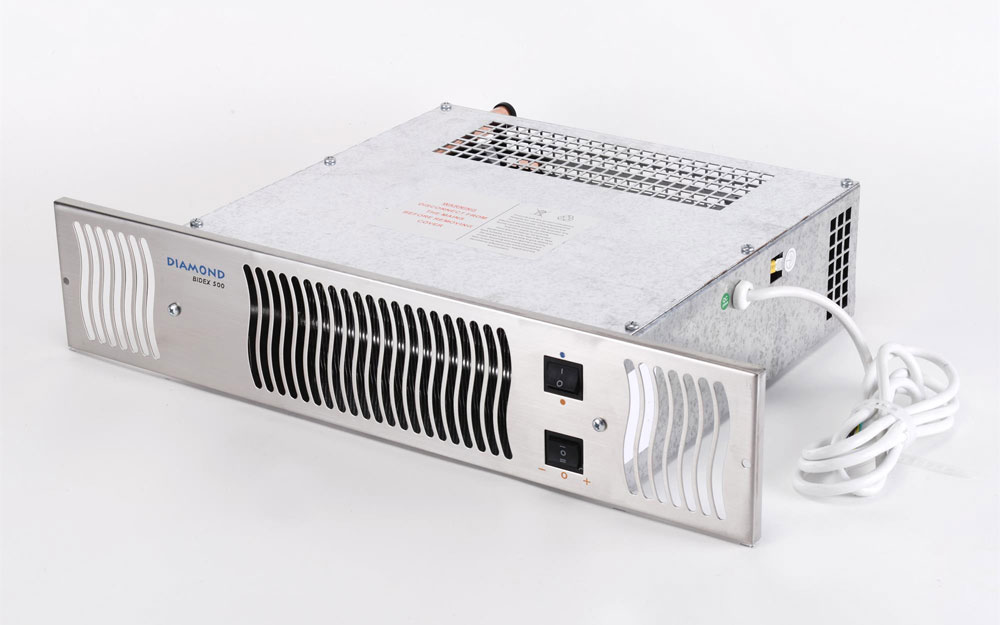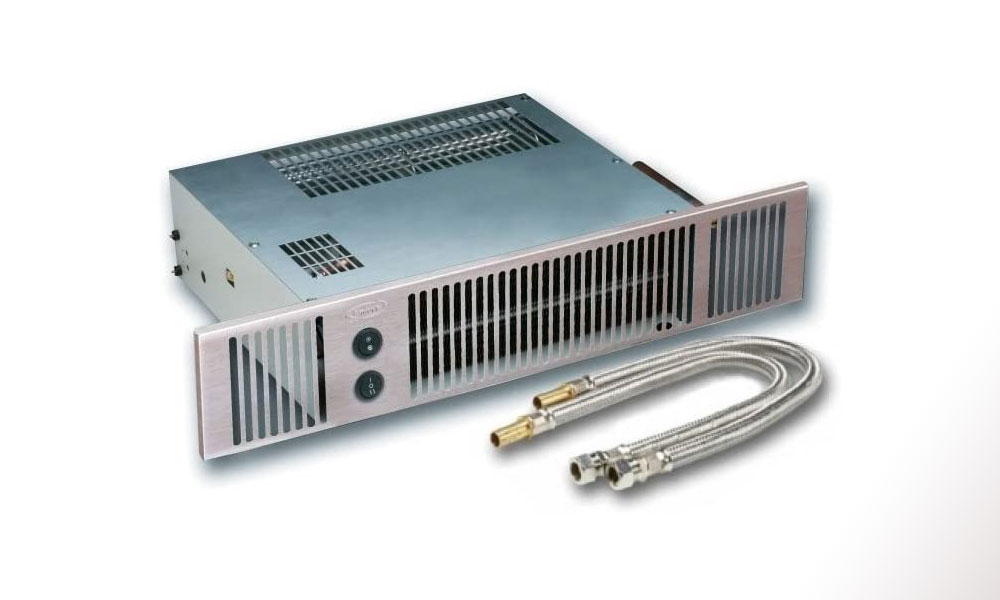Best Kitchen Plinth Heater (Reviews) on the Market – 2023
If you’re looking to save space, lower your power bill, and improve the heating system in your kitchen, you should definitely consider a plinth heater.
Unlike traditional radiators, kitchen plinth heaters don’t hog your walls and floors; just install them at the bottom of your cabinetry, and voila! You have effective heating (almost) completely out of sight and mind!

Today, we’re taking a look at the best kitchen plinth heaters on the market.
While each fits a different set of requirements, all have been selected for their ease of installation, low maintenance, efficiency, and overall value for money.
If you’re not 100% sure which is the best fit for your kitchen and budget, take a look at our buyer’s guide further down the page.
The Best Kitchen Plinth Heater
As with most things, shopping for the perfect kitchen plinth heater can be hard. After all, there’s the upfront cost and installation fees to consider, plus the long-term implications on your comfort and power bill.
To make your life easier, we conducted our own market research. Below, we review the five best kitchen plinth heaters; the first two are electric, the second two are hydronic, and the last one is a dual-fuel model.
Consider the needs of your kitchen, then pick accordingly!
1. Winterwarm WWFH20E 2000W Electric Plinth Heater
Topping our list is a true best-seller: the WWFH20E from Glen Dimplex subsidiary Winterwarm. Perhaps it’s the elegant soft white finish, the high heat output, or just how easy to use. Whatever the case, you may find this was just the plinth heater your kitchen has been asking for!

Dimensions:
- Width – 41cm
- Height – 11cm
- Depth – 21.48cm
- Weight – 2.3kg
Let’s start with the basics–the WWFH20E produces a cosy amount of heat with its 2000W heating element. While it does get quite warm, you won’t have to worry about wayward toes running into scalding grills. Additionally, Winterwarm includes overheat protection and an overload cut-out for further safety.
While there’s no power indicator, there is a large on/off switch on the plate, giving you unambiguous control over when it’s in operation and not. Of course, if you’re like most people, you probably don’t want to go bending all over to fiddle with switches! In this case, rest easy knowing Winterwarm included a Bluetooth remote control, with which you can turn it on/off and adjust the thermostat settings.
And yes, unlike many kitchen plinth heaters, the WWFH20E does indeed have a fully programmable thermostat and 7-day timer! Left to its own devices, your Winterwarm will politely shut off once it’s reached the desired temperature, then quietly hum back to life when the temperature begins to noticeably drop. That means you don’t have to worry over wasted energy or uncomfortable temperatures on the odd-hours.
Keep in mind, there’s no plug with this one–you’ll need to install the 3-core wire into a fuse spur. If you’re not handy with this sort of thing, seek the guidance of a licensed professional.
Overall, for the Winterwarm WWFH20E kitchen plinth heater offers real value for money, ease of use, good looks, and of course plenty of toasty warmth.
Pros:
- Durable steel construction with attractive white powder-coated finished
- Full thermostatic programmability via remote control
- Affordable
- Quiet, fan-blown heat
- 1-Year warranty
Cons:
- No neon power indicator
- Bluetooth connectivity can be a little finicky
- Not at all waterproof
2. Smith’s Space Saver SS3E Electric Plinth Heater
True to its name, the Smith’s Space Saver SS3E allows you to warm up kitchens which don’t otherwise have the space to accommodate a full-sized radiator. Given that, it’s natural to assume that this slim plinth heater would necessitate some compromise to heating–but think again.

Dimensions:
- Length – 60cm
- Height – 10cm
- Depth – 16.5cm
- 5kg
Smith’s Environmental Products (which we’ll shorten to “Smith’s” from here on) has equipped the SS3E with a powerful 3000W heating element. This is not only an adequate replacement for a standing rad, it’s actually more power than many dedicated space heaters will produce.
And if all that sounds like too much heat for your bite-sized kitchen space, rest easier knowing there’s adjustable heat output. On the face of the unit are three illuminated switches: The left-hand switch is for 1kW, the right-hand is for 2kW, and flipping both gives you 3kW output.
But once again, we live in the 21st century, so it’s almost never necessary to get down on all fours to adjust the heat. The SS3E also ships with a dedicated Heating Control module, which mounts nicely as a semi-permanent and fully convenient fixture in your kitchen. Control the heat output, as well as the period of time–all without breaking your back!
Once again, we recommend you reach out to a qualified technician for installation–unless of course, you’re comfortable wiring a spur into your ring mains.
Whatever you do, make sure never to install your SS3E in a washroom or any other high-humidity application. Very few electric plinth heaters have the protections needed to make this safe. But in general, the Smith’s SS3E is indeed very safe, with an overheat protection switch which cuts the power when it detects potentially dangerous overheating.
So, who’s it for? If you’ve got a small kitchen or a room separate from central heating, you’ll love Smith’s SS3E plinth heater.
Pros:
- Sturdy stainless steel build with a whopping 5-year warranty
- Variable, high-cap heating element for plenty of heat
- Efficient, quiet convector fan and Lot 20 energy compliance
- Neon power light and illuminated switches
Cons:
- Not much, but similar heat output can be had at lower prices
- Not intended for use in the bathroom
3. Bidex Diamond 500 hydronic plinth heater
If you are looking for the most hands-off heating for your kitchen (and you’re in close proximity to the central heating system), skip the electric plinth heaters in favour of the hydronic Diamond 500. Not only is it completely automatic, it categorically saves money on your monthly utility bill, as well.

Dimensions:
- Width – 50cm
- Height – 10cm
- Depth – 40cm
- Weight – 5.9kg
Unless you’re a plumber–it will be very difficult to install the Diamond 500 without hiring a qualified technician. After all, this kitchen plinth heater works differently to electric counterparts by tapping directly into your heating pipes.
Essentially, there’s a temperature switch inside, which detects the overall heat produced by the water piping through from the combi boiler. Once it hits a certain threshold, a fan kicks on, blowing the heat off the exchanger and onto your frosty toes.
Because hydronic plinth heaters respond to your central heating system, you control it from your main thermostat. Rather than being its own isolated system, the Diamond 500 is essentially a natural extension of your central heating system, purpose-built to drive the chill from your kitchen.
However, the Diamond 500 isn’t fully passive. You have some extra control over the heat output by way of a simple output switch on the grille. The standard output is 3057BTU (equivalent to 896W, which is enough to fill a 27m3 space); but you can also kick the fan into high gear which boosts output 30% to 3979BTU total. That’s some serious warmth!
Central heating plinth heaters have low maintenance requirements as well; devoid of fragile electric heating elements, you don’t have to worry about built-up dust bunnies gumming up the works and posing a fire hazard. If you ever do have an issue with your Diamond 500, Bidex offers a 2-year warranty to protect your purchase against faulty manufacture.
Pros:
- Largely automatic operation, with controls for extra heat or to shut the fan off
- Comes with all necessary hoses and isolation valves
- Highly energy-efficient yet effective heating
- No danger of overheating
- UK manufactured
Cons:
- Fan isn’t as quiet as other models on our list
4. Thermix KPH-1500 Classic hydronic plinth heater
The UK is famous for its wonderful weather, so who better to design a kitchen plinth heater than British-based company Thermix? On offer here are four technically identical versions of their classic KPH-1500 central heating plinth heater, available in black, white, silver, or brushed stainless steel.

Dimensions:
- Width – 50cm
- Height – 10.5cm
- Depth – 29cm
- Weight – 4.5kg
Beyond the satisfaction of buying a domestic product, the KPH-1500 is easy to recommend for its performance. It offers a dual heating mode, outputting 1260W and 1450W (close to 5,000BTU!) respectively. Just flip a switch on the grille, and you’re on your way to tailored warmth!
Like other hydronic plinth heaters, the KPH-1500 is responsive to your central heating system. Once it detects water within its tubes at a temperature ≥38°C, the fan kicks on and pushes rapidly convected heat out into your kitchen. It does get toasty, but don’t worry about burning yourself–the grill won’t ever get scalding hot.
Due to the lack of heating element, there’s no need for an overheat cut-off, making the KPH-1500 one of the most categorically safe plinth heaters out there. The hassle of this unit is frontloaded–as you’ll need an experienced plumber to handle the install, or else some serious DIY skills.
Once installed under the cupboard, however, maintenance is minimal to the extreme. If you do need the bleed the air in the unit, there’s a handy bleed screw to make it simple. Thermix provides an exceptional 2-year warranty on parts, repair, and replacement–so as long as everything is installed correctly, you’re guaranteed a minimum service life.
Finally, whilst grill styling is up to personal taste, the KPH-1500 is our personal favourite design. The fact that it bears just a single switch and a variety of fascia colours means that you can really fit it to suit your kitchen décor.
Pros:
- Awesome grill design in multiple colours
- Tremendous variable heat output
- Solid steel construction with a great warranty
- Designed and made in the UK
- Quiet fan
Cons:
- It’s not cheap, and some colours are more than others
5. Smith’s Space Saver SS5/Dual dual-fuel plinth heater
Up to this point, we’ve presented either electrical or hydronic options to heat your kitchen. But the Smith’s SS5/Dual plinth heater obviates the need to choose entirely. It’s definitely the most expensive unit on our list of kitchen plinth heaters, but nothing rivals its sheer utility.

Dimensions:
- Width – 50cm
- Height – 10cm
- Depth – 28.8 cm
- Weight – 6kg
Essentially, you get the best of both worlds. Whenever possible, the SS5/Dual will default to highly efficient hydronic heat. By default, you’ll enjoy 1.3kW/4400BTU, but on cold days you can kick in the boosted mode for increased 1.7kW/5800BTU heat. It’s effective, and you’ll save a bundle on your power bill relative to a plug-in electric radiator.
However, there may be times of the year when it’s too warm to justify running the central heating, yet the kitchen tiles are still chilly to the touch. In this case, just activate the electric heating element (rated at 1kW/3450BTU) for instant warming!
The Smith’s SS5/Dual also works in the summer, too. You can skip the heating altogether, and activate the fan separately to circulate cool air about your feet.
So, the SS5/Dual is an all-weather environmental upgrade, but did you know it can unlock your creative side as well? If ever you decide to redesign your kitchen, you won’t have to work around your (non-existent, bulky) panel radiator.
That means, go ahead and install that cabinet, then throw the SS5/Dual underneath for satisfaction and warmth; build that add-on you’ve always wanted, and fear not for its lack of connection to central heating! If that weren’t enough, you can choose from brown, black, chrome, and white grilles for the perfect accent to your kitchen décor.
Just keep in mind, you’re really going to need a professional technician to install Smith’s dual fuel plinth heater in your kitchen.
Pros:
- Amazing 5-year warranty from Smith’s
- Extremely flexible heating and cooling solution for your kitchen
- Great build quality, and attractive grille design in multiple colours
- Made in the UK
Cons:
- Expensive
- Heating element isn’t as powerful as what’s found on dedicated electric plinth heaters
- No power indicator light
- Not waterproof
How to pick the right plinth heater for your kitchen
Compared to most types of products out there, plinth heaters are a relatively niche appliance. While there isn’t quite the overabundance of options there could be, it’s still a crowded marketplace that can lead to analysis paralysis.
Considering how most kitchen plinth heaters require professional installation, you’re going to want to ensure that the unit you choose perfectly suits your needs. After all, it would be quite the expensive mistake to discover only after you’ve already hired the technician!
Below, we present a short buyer’s guide to help you identify and prioritise your requirements–and to help you find the best kitchen plinth heater to satisfy them!
Consider the requirements of your kitchen space for installation
Virtually any kitchen can accommodate a plinth heater, as there’s no lack of cabinetry to house your unit. However, it’s important to realise that not all plinth heaters are the same size. Even minor dimensional variances can make the difference between a safe, effective installation and a giant waste of time and money.
Usually, the width is the easiest dimension to accommodate, as you (or your technician) will be cutting the hole appropriately. For functionality’s sake, you’ll need to pay special attention to the height and depth, as these affect the airflow needed for proper heating.
In general, you need to position your kitchen plinth heater so that there’s 2cm of clearance between the top of the heater (not necessarily the grille) and the underside of the shelving above. Additionally, you’ll want at least another 5cm or so between the rear of the heater and the back wall.
While this sounds restrictive, most cabinetry will have sufficient clearance for your plinth heater. What’s more, installing a plinth heater will make your old panel rad obsolete, allowing you to remove it and free up more space for more cabinetry or appliances.
Consider the source of your heating
Hydronic plinth heaters require ready access to both the electrical mains (for the fan) and central heating. Sadly, this means you will not generally be able to use the higher-efficiently hydronic heaters in add-ons or standalone buildings divorced from the central heating system. It’s easy enough to run electrical wire to an extension of your home, but adding new plumbing is a serious undertaking.
Electronic plinth heaters, on the other hand, are far more flexible. Most ship with a 2m cable which needs to be wired up to the mains as a fused spur. Of course, if you need more length, it’s easy enough to extend it out to the nearest plug. Electrical heaters won’t have the sheer efficiency of their hydronic counterparts, but the difference isn’t so dire that you’d regret taking the electric alternative to frosty feet!
Dual-fuel heaters have all the flexibility of an electrical heater, though they are best installed in tandem with the central heating system. If you’ve got the right space in your kitchen and your budget, this is the way to go for maximum comfort and long-term savings.
Picking the right heat output for your room
While there are a lot of really excellent, high-powered plinth heaters out there, it might be overkill if you’ve got a smaller kitchen. On the flip side, getting an underpowered heater will waste energy and leave you cold.
There are a couple of solutions to this conundrum:
- Calculate the required BTU to fill your kitchen size – This is a rough rule of thumb, but for kitchens and other common areas, you’ll want to take the cubic feet of your space and multiply it by 3. To throw out some rough numbers, you may know your kitchen is 30m3, which converts to a little over 1000ft3. Multiply it by 3, and you’ve got a 3000BTU requirement to easily heat the room. Simple!
- Buy units with variable power outputs or thermostats – Many electronic plinth heaters will have some thermostatic control, so if your heater output exceeds the requirement of your kitchen space, it’s easy enough to set it to the proper temperature rather than burning you out. Hydronic heaters, on the other hand, are a little less flexible, but usually ship with some functionality to cut or boost their output via a switch on the front panel. Make sure your kitchen plinth heater offers some sort of option for managing heat!
Make sure there’s a warranty
Fortunately, plinth heaters are relatively simple as far as machines go, and shouldn’t give you too much trouble or require extensive maintenance. That said, mass-production inevitably results in a few lemons here and there. Thus, it’s crucial to ensure your manufacturer of choice offers a meaningful guarantee of some kind to hedge against faulty workmanship.
Keep in mind, most brands are less willing to honour guarantees for plinth heaters not installed by a qualified technician. They may ask for a receipt for the work as proof, so if you’re a DIYer you may run into trouble. Sure, it’s an extra expense to hire someone, but you get both guaranteed product longevity and the most efficient (and safest) operation in return.
Consider it a sound investment in the comfort of your kitchen!
Conclusion
If you’ve been living with a cranky old radiator that does better at taking up space than heating it, there’s good news! There’s a wide range of quality kitchen plinth heaters which work a treat to keep your toes nice and toasty, all without taking up precious living space. Now, you can remodel your kitchen and achieve that open plan you’ve always dreamed of–or at least stop shaking in your boots for a start.
We carefully picked five of the best kitchen plinth heaters on the market; some have electrical heating elements, others are powered by your central heating system, and one even uses both fuels! The point is, there’s something out there for everyone–just make sure you know what you’re looking for.
Are you planning to swap out your outdated, bulky heater for a compact kitchen plinth heater? Did any of our recommendations fit your requirements? Do you have any tips for our other readers? Let us know below!